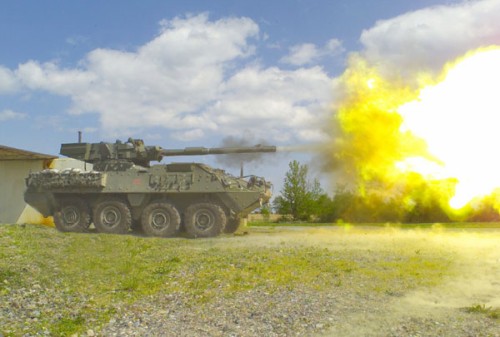
MILITARY VEHICLES
The story of the Stryker Armored Vehicle 

The Stryker is a family of eight wheeled, all wheel drive, armored combat vehicles produced by General Dynamics Land Systems and is in current use by the US Army. It is the first military vehicle to enter service in the US military since the M2 Bradley in the 1980s. The Stryker is based on the Canadian LAV III light-armoured vehicle, which in turn is based on the Mowag Piranha. Stryker is named in honor of two American servicemen: Spc. Robert F. Stryker, who received the Medal of Honor for his actions during the Vietnam War, and Pfc. Stuart S. Stryker, who received the award for his actions during World War II. Both men were killed in action.
 
Private First Class Stuart Stryker, who served with the 513th Parachute Infantry, posthumously received the Medal of Honor for leading an attack near Wesel, Germany that captured more than 200 enemy soldiers and freed three American pilots
Specialist Robert Stryker, who served with the 1st Infantry Division, was posthumously awarded the Medal of Honor for saving the life of his fellow soldiers near Loc Ninh, Vietnam ****

Stryker vehicles position themselves in the town of Samarra, a town northwest of Baghdad, Iraq, December 2003.
A number of subcontractors are used to produce the different LAV configurations and equipment. The prime contractor - GM General Dynamics Land Systems Defense Group LLC -- conducts work in four primary locations. Structure, fabrication and final assembly of the LAVs takes place in both Anniston, Ala., and London, Ontario in Canada. Engineering takes place in Sterling Heights, Mich., and upper hull structures are produced at a plant in Lima, Ohio.
The contract provides the Interim Brigade Combat Team with two vehicle variants that are deployable anywhere in the world in combat-ready configurations. The two variations of the LAV III that are produced for the Interim Armored Vehicle program are the Infantry Carrier Vehicle and the Mobile Gun System. The Stryker has eight configurations besides the basic infantry carrier model - mortar carrier, reconnaissance vehicle, anti-tank guided missile vehicle, fire-support vehicle, engineer support vehicle, command-and-control vehicle, medical-evacuation vehicle and the NBC reconnaissance vehicle. The Strykers are not a replacement for the M1 Abrams tank or the M3 Bradley Infantry Fighting Vehicle. The Strykers are used in places, such as urban areas, where the heavy armored vehicles are not suitable for the mission.
****

Marshall Brain from "How Stuff Works" checked out a Stryker Infantry Carrier Vehicle on display at the 2006 Chicago Auto Show. Watch him explore its amazing features inside and out in the video above.
The Stryker is a full-time four-wheel drive, selective eight-wheel drive, armored vehicle weighing approximately 19 tons. The Stryker can reach speeds of 62 M.P.H., on the highway, has a maximum range of 312 miles, and is transportable aboard C-130 and bigger payload aircraft. The basic Infantry Carrier Vehicle variant (Stryker ICV) has armor that protects its two-man crew and nine on-board solders from machine gun fire, mortar and artillery fragments. The Stryker ICV variants includes configurations for Reconnaissance, Anti-Tank attack, Guided Missile defense and Medical Evacuation missions, as well as carriers for Mortars, Engineering Squads, Command Groups, and Fire Support Teams. The Mobile Gun System (Stryker MGS) variant consists of a Land Systems-designed 105mm cannon mounted in a low-profile turret that is integrated into the Stryker chassis.

General Dynamics Online Stryker Brochure
Strykers can be transported on the ground using trucks or by air on C-17, C-5 and C-130 aircraft. The C-5 and C-17 aircraft can carry seven and four Strykers respectively. The C-130H can fly safely carrying a maximum 38,000lb load for up to 1,000nm. The Stryker's weight, 36,240lb, and size are within the payload limit of the C-130H. The C-130 can operate from smaller airfields in more remote locations. All configurations of the Stryker can disembark from the C-130 in combat ready status.

Weight: 19 tons
Powertrain: similar engine used in Family of Medium Tactical Vehicles (FMTV)
Speed: in excess of 60 mph
Cruising range: in excess of 300 miles on 53 gallons of fuel
Three block improvements are planned for the Stryker. A crew-installable add-on armor kit that provides 360-degree RPG-7 protection, an internal recoil-mounted 120mm mortar system, and embedded training that will be provided beginning with the third SBCT. Block improvements will be retrofitted to SBCTs 1 and 2 in subsequent years.

~Tribute To Our Troops~
|
|
|









